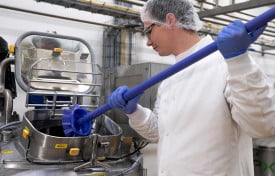Food Safety

- December 06, 2017
Have you contemplated starting a color-coding program in your facility? Have you ever asked yourself the question, why color-code? Even though it is not a standard or requirement, the peace of mind it can give you, regulators & auditors, and ultimately your end consumer has made it one of the biggest industry trends in recent years. Having the proper color-coded products can promote organization and efficient work flow, reduce the risk of cross-contamination, designate critical control areas, and avoid bacterial and allergen migration. By implementing a color-coding program, you’re building a strong foundation for your facility.
- May 16, 2017
In February I had the opportunity to attend the “Artisan Dairy Producer Food Safety Initiative Workshop” to learn about the Food Safety Modernization Act (FSMA) along with other leaders in the dairy industry here in Wisconsin. It was put on by the Wisconsin Cheese Makers Association and was offered at no expense thanks to a generous grant from USDA-NIFA. Marianne Smukowski, from the Center for Dairy Research (CDR) and Matt Mathison from the Wisconsin Milk Marketing Board (WMMB) were the trainers for the workshop. The workshop was a brief overview of the expectations that the FDA has put before every business in the food industry, from the large to the small plants. This workshop was geared towards the dairy industry, focusing on the hazards that arise, and how to put a detailed plan together to prevent them. One of the hazards that was of special interest, especially due to the sheer amount of news coverage that it has gotten in the previous months, was the elimination and prevention
- August 30, 2016
When I joined the lab team in May I was familiar with lab equipment and testing but I wasn’t familiar with luminometers and ATP. I had heard
- January 13, 2016
When preparing 3M™ Petrifilm™ for use in your environmental monitoring program there are different hydration methods to follow, depending on the test and the context in which it is used.
For air or direct contact procedures where Aerobic Count, Coliform Count, E.coli/Coliform Count, Rapid Coliform Count or Enterobacteriaceae Count Petrifilm™ are being used, hydrate plates with 1 mL of appropriate sterile diluent. Allow hydrated plates to remain closed for a minimum of 1 hour before use. If using Staph Express Count Petrifilm™, hydrate plates with 1 mL of appropriate sterile diluent. Refrigerate hydrated plates for a minimum of 3 days before using.
For air testing using either Yeast and Mold Count or Rapid S. aureus Count Petrifilm™, hydrate plates with 1 mL of appropriate sterile diluent. Allow hydrated plates to remain closed for a minimum of 1 hour before use.
- October 21, 2015
Nelson-Jameson, Inc. and DSM are proud to announce a new Delvotest® Antibiotic Residue Tests website! Geared towards meeting the needs of dairy farmers, dairy labs, and artisan/farmstead operations, the site features information on an array of kits, troubleshooting tips, and order links.
As part of our mutual commitment to food safety, Nelson-Jameson, Inc. and DSM sought to create a site where users in the Americas could learn more about the dangers of antibiotic residues in milk and how to most effectively select and utilize Delvotest® products to both protect the public health and the economic vitality of their dairy/cheese operations.
To check out the Delvotest® site you can click here, enter “nelsonjameson.com/delvotest” into your web
- August 12, 2015
Small poultry, meat, and processed egg product businesses, do you know there is a free resource out there to help you negotiate/understand food safety concerns and other USDA-related topics? Since 2009, the U.S. Department of Agriculture’s Food Safety and Inspection Service (FSIS) has been operating a Help Desk for small operators.
One can either call the Help Desk at 1-877-FSISHELP (1-877-374-7435) or email the help desk at: InfoSource@fsis.usda.gov . Those using the Help Desk can expect that:







